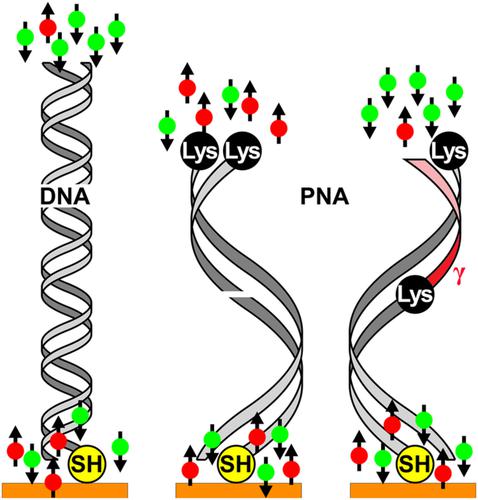Our official English website, www.x-mol.net, welcomes your
feedback! (Note: you will need to create a separate account there.)
Spin‐selective electron transmission through self‐assembled monolayers of double‐stranded peptide nucleic acid
Chirality ( IF 2.8 ) Pub Date : 2021-01-05 , DOI: 10.1002/chir.23290 Paul Valerian Möllers 1 , Selma Ulku 2 , Dilhara Jayarathna 2 , Francesco Tassinari 3 , Daniel Nürenberg 1 , Ron Naaman 3 , Catalina Achim 2 , Helmut Zacharias 1
Chirality ( IF 2.8 ) Pub Date : 2021-01-05 , DOI: 10.1002/chir.23290 Paul Valerian Möllers 1 , Selma Ulku 2 , Dilhara Jayarathna 2 , Francesco Tassinari 3 , Daniel Nürenberg 1 , Ron Naaman 3 , Catalina Achim 2 , Helmut Zacharias 1
Affiliation

|
Monolayers of chiral molecules can preferentially transmit electrons with a specific spin orientation, introducing chiral molecules as efficient spin filters. This phenomenon is established as chirality‐induced spin selectivity (CISS) and was demonstrated directly for the first time in self‐assembled monolayers (SAMs) of double‐stranded DNA (dsDNA)1. Here, we discuss SAMs of double‐stranded peptide nucleic acid (dsPNA) as a system which allows for systematic investigations of the influence of various molecular properties on CISS. In photoemission studies, SAMs of chiral, γ‐modified PNA show significant spin filtering of up to P = (24.4 ± 4.3)% spin polarization. The polarization values found in PNA lacking chiral monomers are considerably lower at about P = 12%. The results confirm that the preferred spin orientation is directly linked to the molecular handedness and indicate that the spin filtering capacity of the dsPNA helices might be enhanced by introduction of chiral centers in the constituting peptide monomers.
中文翻译:

通过双链肽核酸自组装单层的自旋选择性电子传输
单层手性分子可以优先传输具有特定自旋方向的电子,从而引入手性分子作为有效的自旋过滤器。这种现象被确立为手性诱导自旋选择性 (CISS),并首次在双链 DNA (dsDNA) 的自组装单分子层 (SAM) 中直接得到证实1 。在这里,我们讨论双链肽核酸 (dsPNA) 的 SAM 作为一个系统,该系统允许系统研究各种分子特性对 CISS 的影响。在光电发射研究中,手性、γ 修饰的 PNA 的 SAM 显示出高达P = (24.4 ± 4.3)% 自旋极化的显着自旋过滤。在缺乏手性单体的 PNA 中发现的偏振值相当低,约为P = 12%。结果证实,优选的自旋方向与分子旋向性直接相关,并表明在构成的肽单体中引入手性中心可能会增强 dsPNA 螺旋的自旋过滤能力。
更新日期:2021-01-20
中文翻译:

通过双链肽核酸自组装单层的自旋选择性电子传输
单层手性分子可以优先传输具有特定自旋方向的电子,从而引入手性分子作为有效的自旋过滤器。这种现象被确立为手性诱导自旋选择性 (CISS),并首次在双链 DNA (dsDNA) 的自组装单分子层 (SAM) 中直接得到证实1 。在这里,我们讨论双链肽核酸 (dsPNA) 的 SAM 作为一个系统,该系统允许系统研究各种分子特性对 CISS 的影响。在光电发射研究中,手性、γ 修饰的 PNA 的 SAM 显示出高达P = (24.4 ± 4.3)% 自旋极化的显着自旋过滤。在缺乏手性单体的 PNA 中发现的偏振值相当低,约为P = 12%。结果证实,优选的自旋方向与分子旋向性直接相关,并表明在构成的肽单体中引入手性中心可能会增强 dsPNA 螺旋的自旋过滤能力。











































 京公网安备 11010802027423号
京公网安备 11010802027423号